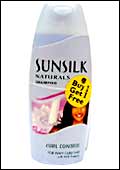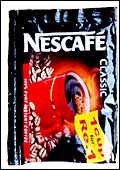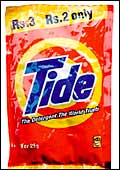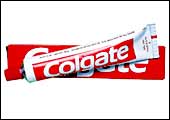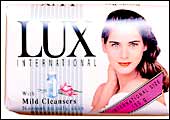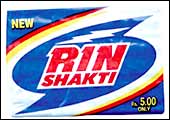 |
| A local kirana store: The consumers
are back |
There
is a spring in the step of almost every fast moving consumer goods
(FMCG) marketer these days. In the past two months alone, the
sector's best-known company, Hindustan Lever Limited (HLL), made
over half-a-dozen presentations to a clutch of blue-chip foreign
institutional investors in Mumbai, New Delhi and Singapore. In
contrast, there were just five such from the company's investor
relations team last calendar, 2004.
Make no mistake, the feel-good factor is
clearly back in the sector. After almost three years of a long,
dry winter, sales growth is back in the Rs 48,000-crore FMCG sector.
And it looks like it's here to stay. HLL has posted double-digit
growth, after almost five years, in the past six months. Cigarette-to-hotels
major ITC's two-year-old non-cigarette FMCG business grew over
87 per cent in July-September 2005, prompting the company to revise
its non-cigarette FMCG target to Rs 1,000 crore, up from Rs 800
crore for 2005-06.
For the same period, Dabur India's sales
are up 26 per cent and Procter & Gamble Hygiene and Health
Care's 35 per cent. It's the same happy story of strong double
digit growth (see Growth Is Back Across The Board), which repeats
itself in most other companies such as Colgate-Palmolive India,
Godrej Consumer Products, GlaxoSmithKline Consumer Healthcare,
and Nestle India.
"In FMCG you don't see a sudden downtrend
once a momentum has been built," says Atul Rastogi, an FMCG
analyst with Mumbai-based brokerage Motilal Oswal. He is right.
The growth was back, almost a year ago, although it was insignificant
at just under 1 per cent; now it has blossomed into strong single
digits, enveloping most categories and players (see It's Springtime
Once Again For FMCG). And forget the David versus Goliath story,
even the down-trading scourge of yesteryears. "The trend
of the last two-three years of smaller companies gaining at the
expense of big FMCG players has reversed in the last six months,"
says Siddhartha Roy, Economic Advisor with the Tata Group. "And
consumers are upgrading to products perceived to be high-end."
Even though the current growth, at 5.4 per cent for July-September
2005, is largely urban-led, it is just a matter of time before
the effect of three successful monsoons start kicking in growth
for FMCGs even in the rural markets (where the growth is currently
under 3 per cent).
It's The Economy
A buoyant economy growing at over 7 per cent
has a big role in the current upturn in FMCG sales, in terms of
both volume and value. "The FMCG growth is coming back because
of the overall buoyant economy," says Satish Kumar, Managing
Director, Henkel Spic. In line with strong GDP and buoyant consumer
sentiment (highest ever in the last three years, according to
bt-Indica Research Index of Consumer Sentiment, May 2005) July-September
2005 saw the sixth consecutive quarter of positive urban growth
and the third for rural growth for FMCGs.
The rural FMCG market went through a decline
of 6.7 per cent in 2003, and remained in negative territory for
all of 2004. The beginning of 2005 saw it picking up slowly, reaching
a not-too-bad 2.8 per cent growth in July-September 2005. Urban
growth touched a reassuring strong single digit only around the
end of last year, coming after negative growth for 2002, 2003
and much of 2004.
"There was a long period of stagnation
in FMCGs. The resurgence, though clearly visible, is slow,"
says R. Subramanian, md, Subhiksha, a discount food chain company
based in Chennai. As the economy slumped in 2002-03 (GDP growth
3.7 per cent), the FMCG market took almost a year before the adverse
impact kicked in, with growth at a negative 2.5 per cent in 2003.
And even though the economy picked up nicely to post an 8 per
cent GDP growth in 2003-04, it was only around the end of last
calendar that any real growth started trickling in for FMCGs.
So, even though the GDP-FMCG growth linkages, once again, are
clearly established, there is this time lag before the sector
starts mirroring the big picture (read: the economy).
Investing In Building Momentum
"A substantial part of the FMCG growth
of 13 per cent (in value terms) is driven by volume growth coming
out of the real income growth and the rest is inflationary, accounted
by the marginal price hikes, which the sector has been able to
effect this time," says Tata's Roy. This marginal price hike
read together with the sector's slight dip in margins, and huge
jumps in advertising and promotional (A&P) spends, is actually
good news for the sector (see Higher Ad Spends Is Good News).
It shows that the sector is not just content with harvesting its
good fortune, because of the upbeat economy, but equally willing
to invest and strive for higher growth.
| Costs Down, Prices Up, Money For Growth |
|
In a quest to lower costs, most
FMCG biggies are moving large part of their manufacturing
to notified backward regions (such as Assam, Jammu & Kashmir,
Sikkim, Himachal Pradesh and Uttaranchal), where there is
a huge, around 5 to 6 per cent, savings on excise tax. Almost
half of Dabur India's production is in these tax heavens,
and it is set to go up to 70 per cent by end of 2005-06.
Implementation of the value-added tax (VAT) regime, across
19 states this year, has also brought raw material costs
down for FMCG companies, helping them shave costs further,
though there has been some cost pressure on petroleum-based
inputs, such as packaging material. Analysts point out that
in a buoyant, growing market, the companies have been able
to pass on the inflationary cost to the consumers without
sacrificing volumes or market share. This, coupled with
the sector's focus on margin rich brands, sometimes at the
cost of low margin brands, have had a positive impact on
gross margins. The obsession with growth, though, has meant
that all these savings are going into supporting an aggressive
advertising & promotional stance, instead of bolstering
the bottom line.
|
And what's important is that companies in
the sector are using price hikes and cost savings, by moving large
part of their manufacturing to low-tax havens such as Himachal
Pradesh and Uttaranchal, to support higher A&P spends, instead
of fattening their profits, a practice followed by most companies
during the FMCG downturn (see Costs Down, Prices Up...). Even
a highly bottom line-sensitive company such as HLL has seen its
margins decline over 1 per cent and A&P spend go up by 0.6
percentage point for July-September 2005. The jump of 46.28 per
cent (for July-September 2005) in Colgate-Palmolive's year-on-year
A&P spend shows its born-again aggressiveness to capture a
larger share of the growing business. The company's A&P spend
dipped from Rs 185 crore in 2002-03 to Rs 148 crore in 2003-04,
hitting a low of Rs 137 crore in 2004-05.
It is interesting to note that all these
A&P spends are not just going merely to support existing brands,
but also support the flurry of new launches and re-launches that
the sector is witnessing after almost a two-three year hiatus.
HLL has already re-launched over two dozen brands, including Annapurna
atta, Red Label tea, Rexona soap, Fair & Lovely, Lux and Axe,
in last nine months. For Dabur, the aggressive A&P push on
recently launched products has meant around 6 per cent of sales
coming from them in the first half 2005-06.
Sensing consumers' readiness to experiment
and adopt new products, new launches are happening across various
categories: Marico launched Parachute After Shower Hair Cream
nationally around three months ago; Dabur entered the personal
wash category with Vatika's brand extension into a herbal beauty
soap; and fairness cream is now being peddled to men, with the
Kolkata-based Emami Group splurging on a high-decibel ad campaign
to support its new brand, Emami Fair & Handsome cream. GlaxoSmithKline
Consumer launched Boost ChocoBlast, which promises all the energy
of Boost with a chocolate taste. Nestle recently launched ready-to-cook
pastes, and is developing culinary products for Indians living
abroad, which it may launch in India too. "Growth in FMCGs
is apparently linked to innovations, which is what we are beginning
to see in all major companies, including HLL," says Nikhil
Vora, Vice President (Research) at Mumbai-based brokerage SSKI.
"ITC's entry into the foods category, Dabur's into non-herbal
Ayurvedic space and Godrej's global acquisitions bode well for
the industry."
Other Growth Drivers
New retail formats, branded services and
acquisitions provide another lever for the sector to outgrow the
economy, much like other consumer sectors, auto, durables, telephony
and banking. Most FMCG marketers are taking a measure of modern
retail format (MRF) stores such as Big Bazaar and Spencer's, which
already account for around 9 per cent of all FMCG sales in metros.
"MRF is critical for the success of FMCG companies. The format
is playing a major role in big cities with the mall culture picking
up among consumers," says Nick Massey, MD, GlaxoSmithKline
Consumer Healthcare.
HLL, which claims to have already captured
a higher market share in toothpaste, tea and fabric wash at MRF
stores, is waiting to bring Unilever best practices in this arena.
For Nestle, the most urban of all FMCG companies because of its
product skew towards urban consumers, the new MRF stores represent
a big opportunity. "We have created a new department, National
Key Account Management Organisation, to focus on modern formats
in retail," says a Nestle spokesperson. ITC is betting big
on its new rural mall initiative, Choupal Sagar, as it gets deeper
into the FMCG sector and looks at entering product categories
such as soap, detergents, shampoo and skin creams. There are already
three Choupal Sagars in Madhya Pradesh, and another 10 are close
to completion.
Branded services, such as HLL's Ayush Therapy
Centres and Marico's Kaya Skin clinic, are increasingly becoming
critical for FMCG companies in their quest for growth. HLL is
looking at expanding Ayush Therapy centres, currently numbering
18. Marico has raced ahead with its cosmetic dermatological services
network of 39 Kaya Skin Clinics, and is all set to expand the
network to 45 by March 2006.
With MRF's ability to support high-end products,
most Indian FMCG companies are realising the need to build a portfolio
of top-end brands, currently a lacunae in their stable. For Godrej
Consumer, the acquisition of UK's Keyline brands means not only
a foothold in the international FMCG market, but also an opportunity
to bring Keyline brands to India. "The acquisition of Keyline
gives us exposure to (modern) retail trade handling, which will
become very necessary in India shortly," says H.K. Press,
Executive Director, Godrej Consumer. And Tata Tea's recent acquisition
of Good Earth, a specialty tea brand in the US, also means building
scale and size to its global tea brand portfolio, which already
includes UK's Tetley, back home in India. Why, even Dabur's acquisition
of Balsara Home Products in April 2005, gives, at one level, a
somewhat Ayurvedic-focussed company not just an entry into new
product categories, but also the scale and size to compete on
a more equal footing with the biggies in the sector. With so much
happening in the FMCG sector right now, 2002, 2003 and even 2004
looks like a bad dream that is best forgotten.
|





